tow CADILLAC ESCALADE ESV 2010 Manual PDF
[x] Cancel search | Manufacturer: CADILLAC, Model Year: 2010, Model line: ESCALADE ESV, Model: CADILLAC ESCALADE ESV 2010Pages: 620, PDF Size: 7.4 MB
Page 485 of 620

Black plate (37,1)Cadillac Escalade/Escalade ESV Owner Manual - 2010
Overheated Engine Protection
Operating Mode If an overheated engine condition exists and the
ENGINE POWER IS REDUCED message is displayed,
an overheat protection mode which alternates firing
groups of cylinders helps prevent engine damage. In
this mode, you will notice a loss in power and engine
performance. This operating mode allows the vehicle to
be driven to a safe place in an emergency. Driving
extended miles (km) and/or towing a trailer in the
overheat protection mode should be avoided.
Notice: After driving in the overheated engine
protection operating mode, to avoid engine damage,
allow the engine to cool before attempting any
repair. The engine oil will be severely degraded.
Repair the cause of coolant loss, change the oil
and reset the oil life system. See Engine Oil
on
page 7 ‑ 17 . Engine Fan Noise The vehicle has electric cooling fans. You might hear
the fans spinning at low speed during most everyday
driving. The fans can turn off if no cooling is required.
Under heavy vehicle loading, trailer towing, and/or high
outside temperatures, or if you are operating the air
conditioning system, the fans can change to high speed
and you might hear an increase in fan noise. This is
normal and indicates that the cooling system is
functioning properly. The fans change to low speed
when additional cooling is no longer required.
7-37
Page 520 of 620

Black plate (72,1)Cadillac Escalade/Escalade ESV Owner Manual - 2010
Any time you notice unusual wear, rotate your
tires as soon as possible and check wheel
alignment. Also check for damaged tires or
wheels. See When It Is Time for New Tires
on
page 7 ‑ 73
and Wheel Replacement on page 7 ‑ 77 .
When rotating your vehicle's tires, always use the
correct rotation pattern shown here.
Do not include the spare tire in the tire rotation.
After the tires have been rotated, adjust the front
and rear inflation pressures as shown on the Tire
and Loading Information label. See Inflation - Tire
Pressure
on page 7 ‑ 65 and Loading the Vehicle on
page 6 ‑ 32
. Reset the Tire Pressure Monitor System. See Tire
Pressure Monitor Operation
on page 7 ‑ 68 .
Make certain that all wheel nuts are properly
tightened. See “ Wheel Nut Torque ” under
Capacities and Specifications
on page 7 ‑ 117 .
{ WARNING: Rust or dirt on a wheel, or on the parts to
which it is fastened, can make wheel nuts
become loose after time. The wheel could
come off and cause an accident. When you
change a wheel, remove any rust or dirt
from places where the wheel attaches to
the vehicle. In an emergency, you can use
a cloth or a paper towel to do this; but be
sure to use a scraper or wire brush later,
if needed, to get all the rust or dirt off. See
Changing a Flat Tire
on page 7 ‑ 80 .
Make sure the spare tire is stored securely. Push,
pull, and then try to rotate or turn the tire. If it
moves, tighten the cable. See Storing a Flat or
Spare Tire and Tools
on page 7 ‑ 94 .
7-72
Page 527 of 620

Black plate (79,1)Cadillac Escalade/Escalade ESV Owner Manual - 2010
WARNING: (Continued) vehicle and tire size combination and road
conditions. Follow that manufacturer's
instructions. To help avoid damage to the vehicle,
drive slowly, re ‐ adjust or remove the device if it is
contacting the vehicle, and do not spin the
wheels. If you do find traction devices that will fit,
install them on the rear tires.
If a Tire Goes Flat It is unusual for a tire to blowout while you are driving,
especially if you maintain your vehicle's tires properly.
If air goes out of a tire, it is much more likely to leak out
slowly. But if you should ever have a blowout, here are
a few tips about what to expect and what to do:
If a front tire fails, the flat tire creates a drag that pulls
the vehicle toward that side. Take your foot off the
accelerator pedal and grip the steering wheel firmly.
Steer to maintain lane position, and then gently brake to
a stop well out of the traffic lane. A rear blowout, particularly on a curve, acts much like a
skid and may require the same correction you would
use in a skid. In any rear blowout remove your foot from
the accelerator pedal. Get the vehicle under control by
steering the way you want the vehicle to go. It may be
very bumpy and noisy, but you can still steer. Gently
brake to a stop, well off the road if possible.
{ WARNING: Lifting a vehicle and getting under it to do
maintenance or repairs is dangerous without the
appropriate safety equipment and training. If a
jack is provided with the vehicle, it is designed
only for changing a flat tire. If it is used for
anything else, you or others could be badly
injured or killed if the vehicle slips off the jack. If a
jack is provided with the vehicle, only use it for
changing a flat tire.
If a tire goes flat, the next part shows how to use the
jacking equipment to change a flat tire safely.
7-79
Page 531 of 620

Black plate (83,1)Cadillac Escalade/Escalade ESV Owner Manual - 2010
To access the spare tire:
A. Hoist Assembly
B. Hoist Shaft
C. Hoist Shaft Access
Cover/Hole
D. Jack Handle
Extensions
E. Wheel Wrench
F. Hoist Cable G. Tire/Wheel Retainer
H. Spare Tire (Valve Stem
Pointed Down)
I. Hoist Shaft Access Hole
J. Hoist End of
Extension Tool
K. Spare Tire Lock 1. To reach the hoist shaft access cover (C), you will
first need to remove the hitch cover. Remove it by
turning the two fasteners located at the bottom of
the cover counterclockwise and then pull the cover
down and rotate towards you.
2. Open the hoist shaft access cover (C) on the
bumper to access the spare tire lock (K).
3. To remove the spare tire lock insert the ignition
key, turn it clockwise and then pull the lock out.
7-83
Page 532 of 620

Black plate (84,1)Cadillac Escalade/Escalade ESV Owner Manual - 2010
4. Assemble the two jack handle extensions (D) and
wheel wrench (E) as shown.
5. Insert the open end of
the extension (J)
through the hole in the
rear bumper (I) (hoist
shaft access hole). Be sure the hoist end (J) of the extension (D)
connects to the hoist shaft (B). The ribbed square
end of the extension is used to lower the spare tire.
6. Turn the wheel wrench (E) counterclockwise to
lower the spare tire (H) to the ground. Continue to
turn the wheel wrench until the spare tire can be
pulled out from under the vehicle.
If the spare tire does not lower to the ground, the
secondary latch is engaged causing the tire not to
lower. See Secondary Latch System on page 7 ‑ 91
for more information.
7. Use the wheel wrench
hook that allows you to
pull the hoist cable
towards you, to assist
in reaching the
spare tire.
7-84
Page 533 of 620
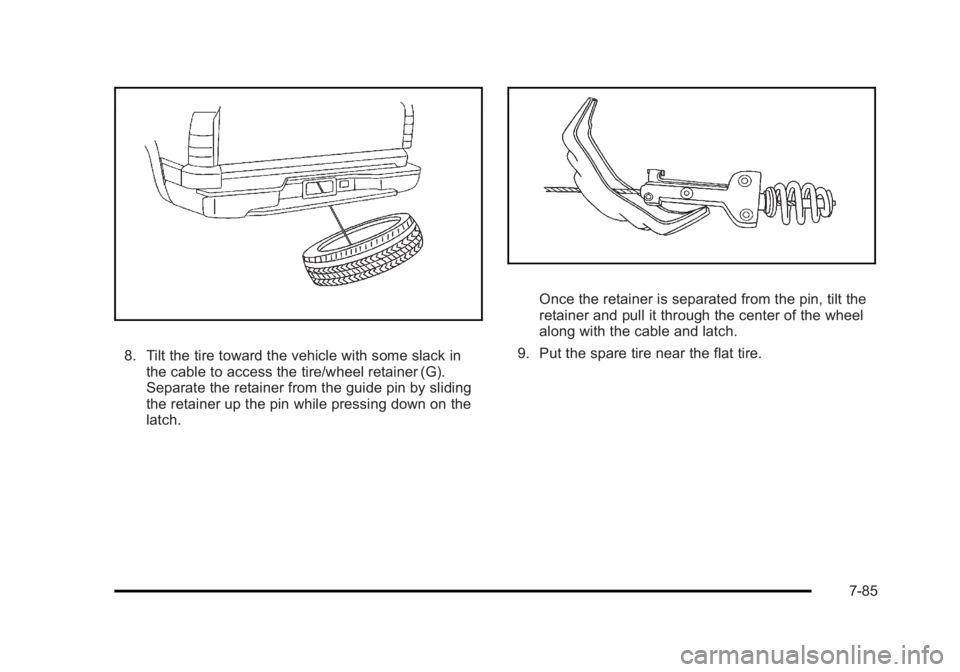
Black plate (85,1)Cadillac Escalade/Escalade ESV Owner Manual - 2010
8. Tilt the tire toward the vehicle with some slack in
the cable to access the tire/wheel retainer (G).
Separate the retainer from the guide pin by sliding
the retainer up the pin while pressing down on the
latch. Once the retainer is separated from the pin, tilt the
retainer and pull it through the center of the wheel
along with the cable and latch.
9. Put the spare tire near the flat tire.
7-85
Page 537 of 620
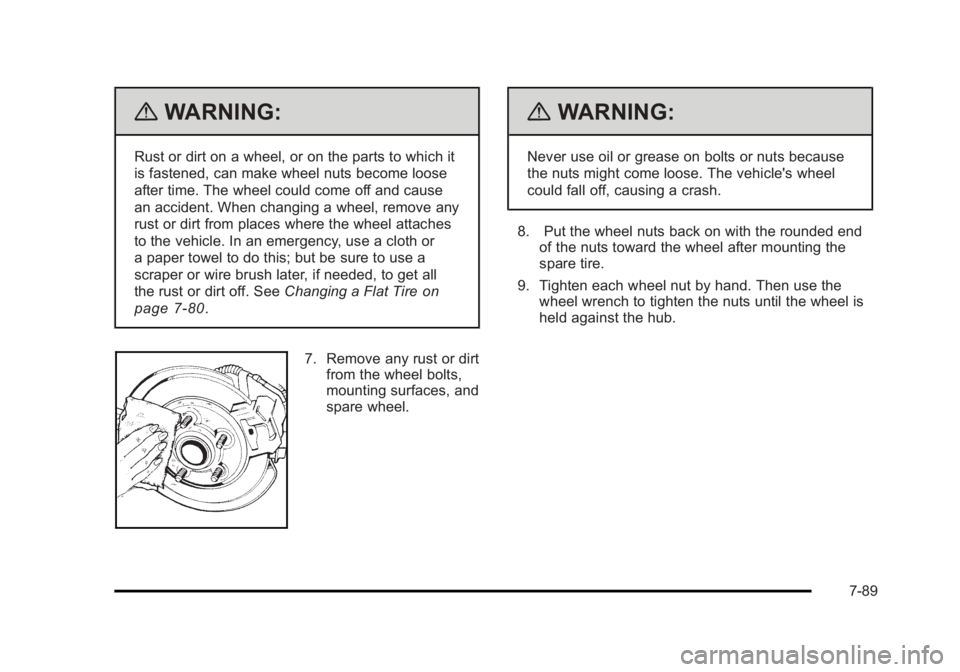
Black plate (89,1)Cadillac Escalade/Escalade ESV Owner Manual - 2010
{ WARNING: Rust or dirt on a wheel, or on the parts to which it
is fastened, can make wheel nuts become loose
after time. The wheel could come off and cause
an accident. When changing a wheel, remove any
rust or dirt from places where the wheel attaches
to the vehicle. In an emergency, use a cloth or
a paper towel to do this; but be sure to use a
scraper or wire brush later, if needed, to get all
the rust or dirt off. See Changing a Flat Tire
on
page 7 ‑ 80 .
7. Remove any rust or dirt
from the wheel bolts,
mounting surfaces, and
spare wheel.{ WARNING: Never use oil or grease on bolts or nuts because
the nuts might come loose. The vehicle's wheel
could fall off, causing a crash.
8. Put the wheel nuts back on with the rounded end
of the nuts toward the wheel after mounting the
spare tire.
9. Tighten each wheel nut by hand. Then use the
wheel wrench to tighten the nuts until the wheel is
held against the hub.
7-89
Page 540 of 620
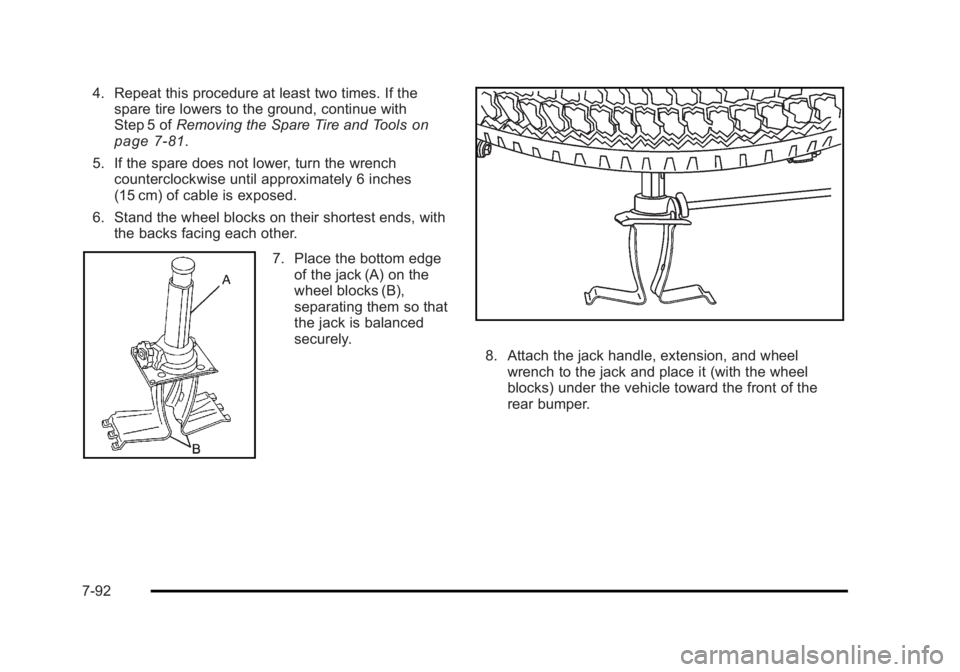
Black plate (92,1)Cadillac Escalade/Escalade ESV Owner Manual - 2010
4. Repeat this procedure at least two times. If the
spare tire lowers to the ground, continue with
Step 5 of Removing the Spare Tire and Tools
on
page 7 ‑ 81 .
5. If the spare does not lower, turn the wrench
counterclockwise until approximately 6 inches
(15 cm) of cable is exposed.
6. Stand the wheel blocks on their shortest ends, with
the backs facing each other.
7. Place the bottom edge
of the jack (A) on the
wheel blocks (B),
separating them so that
the jack is balanced
securely.
8. Attach the jack handle, extension, and wheel
wrench to the jack and place it (with the wheel
blocks) under the vehicle toward the front of the
rear bumper.
7-92
Page 542 of 620
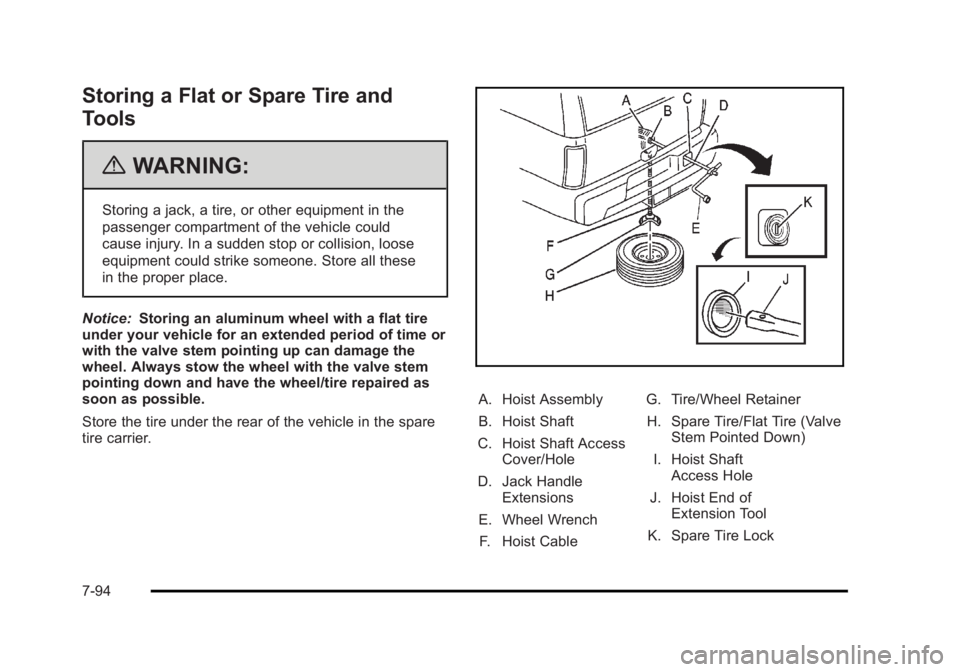
Black plate (94,1)Cadillac Escalade/Escalade ESV Owner Manual - 2010
Storing a Flat or Spare Tire and
Tools
{ WARNING: Storing a jack, a tire, or other equipment in the
passenger compartment of the vehicle could
cause injury. In a sudden stop or collision, loose
equipment could strike someone. Store all these
in the proper place.
Notice: Storing an aluminum wheel with a flat tire
under your vehicle for an extended period of time or
with the valve stem pointing up can damage the
wheel. Always stow the wheel with the valve stem
pointing down and have the wheel/tire repaired as
soon as possible.
Store the tire under the rear of the vehicle in the spare
tire carrier. A. Hoist Assembly
B. Hoist Shaft
C. Hoist Shaft Access
Cover/Hole
D. Jack Handle
Extensions
E. Wheel Wrench
F. Hoist Cable G. Tire/Wheel Retainer
H. Spare Tire/Flat Tire (Valve
Stem Pointed Down)
I. Hoist Shaft
Access Hole
J. Hoist End of
Extension Tool
K. Spare Tire Lock
7-94
Page 543 of 620
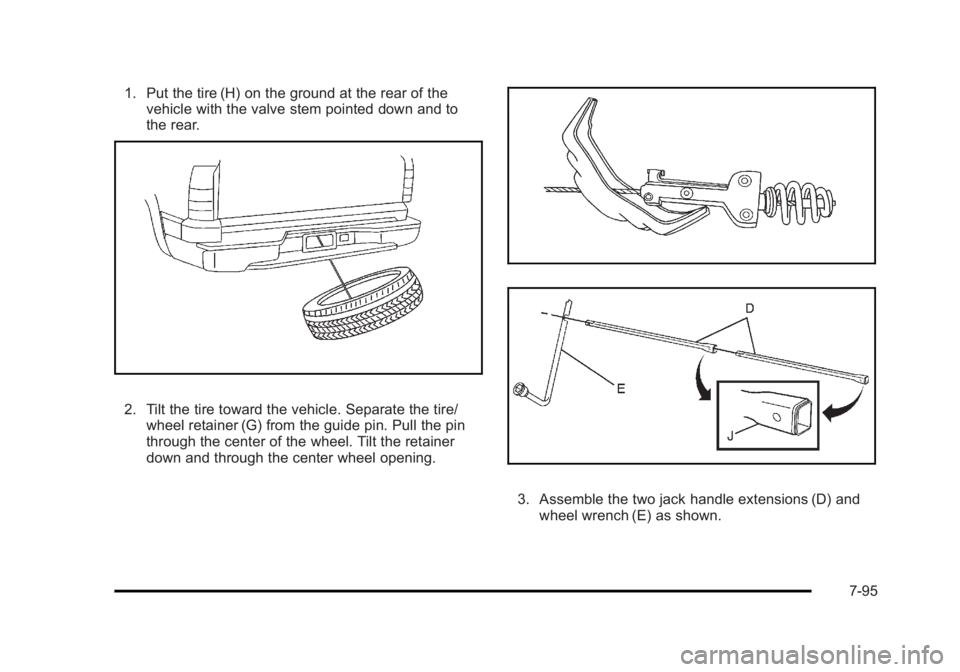
Black plate (95,1)Cadillac Escalade/Escalade ESV Owner Manual - 2010
1. Put the tire (H) on the ground at the rear of the
vehicle with the valve stem pointed down and to
the rear.
2. Tilt the tire toward the vehicle. Separate the tire/
wheel retainer (G) from the guide pin. Pull the pin
through the center of the wheel. Tilt the retainer
down and through the center wheel opening.
3. Assemble the two jack handle extensions (D) and
wheel wrench (E) as shown.
7-95